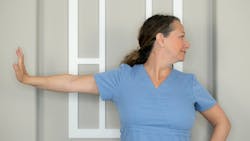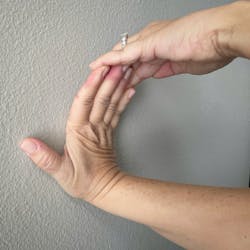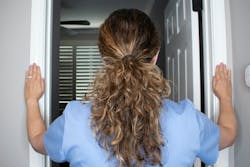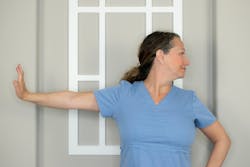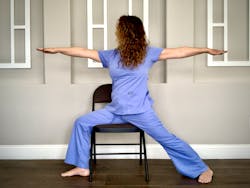5 yoga moves for career longevity
Younger dentists may not notice the aches and pains of practicing dentistry. Perhaps they simply accept it as part of the gig or think it will pass. High levels of stress, on the other hand, are difficult to ignore, and the adverse effects are often surprising. Whether you are new to dentistry or a longtimer, physical fitness and stress reduction are essential for career longevity.
Regularly addressing the physical sequelae of providing dental care is wise. Learning to de-stress helps prevent all-too-common burnout. After all, it would be a shame if repetitive strain injuries or stress-related issues forced you out of clinical practice about the time you paid off your student loans.
A healing modality I recommend is yoga. Yoga stretches stiff muscles while strengthening weak ones. Equally important is that yoga, coupled with mindful breathing, unwinds the mind and activates the parasympathetic nervous system, which keeps you in “rest and digest” mode.
Even if your office is a well-oiled machine, most dentists spend the day in fight-or-flight mode. Thanks to the stress of treating anxious humans, elevated cortisol levels course through the body daily. A study published in Oxidative Medicine and Cellular Longevity found significantly decreased cortisol levels in subjects after a 12-week yoga practice.1 Igniting the parasympathetic system through yoga promotes relaxation, alleviates muscle tension, and improves mood. Yoga poses that challenge your sense of balance also increase focus, so work performance and job satisfaction naturally increase.
Are you in? Start by incorporating simple stretches into your clinical day to counteract the muscular contractions involved in providing dental care. Be mindful to give yourself a break to enjoy a much-needed mental release. The following techniques can be done with or without your personal protective equipment (PPE), between patients, or any time you need a break!
Give yourself a hand
From a standing position, extend your arm and place the palm of your hand flat on a wall. Press your metacarpal pads into the wall. With your free hand, gently pull your fingers and thumb back until you feel a stretch (figure 1). Breathe into the pose, imagining the breath traveling in through your nose, down your arm, and into the wall. Hold and breathe mindfully for 20 to 30 seconds. Repeat with the other hand.
Unhunch yourself
Save your neck
I promise, you have no idea how stiff your neck is.
Reach one arm directly out to the side. Extend your wrist and energetically pressHips don’t lie
A chair without wheels is ideal, but virtually any chair will do. Start with your bum at the front edge of the chair. Pivot your torso to the right, placing your right thigh over the side of the chair and right foot on the floor. Open your left hip by moving your left foot back so your left leg is straight, off the chair, and behind you. Angle your left foot in toward the midline, keeping your left ankle behind your left toes. Keeping your right thigh on the chair, create a T with your arms, palms facing down (figure 4). Gaze over your right hand and hold the pose for three to five breaths. Come back to center and repeat the steps on the left side.
Rest your eyes
As dentists, we stare at the minutiae of the mouth through loupes and then at the blue light of computers and then at our surroundings. Our eyes are like windows, open to constant stimulation. Close your eyes to pause visual input and practice eye yoga.
Read this paragraph before you begin. Ready? Rub your hands together for five seconds or until you feel heat in your palms. Place your warm palms over your eyes, applying firm but gentle pressure to your eye sockets (figure 5). Notice the sense of calm in your nervous system as you give your overstimulated eyes a break. Relax your shoulders, and let air move freely in and out of your lungs. Stay in this position for as long as you’d like but for at least five seconds. Rewarm your hands and repeat three times for optimum relief.
The benefits of yoga are undeniable for dental practitioners. Turning your attention to your body and mind throughout the day lowers stress hormones and leaves you feeling refreshed. There are many yoga poses that can be done while at work, but a regular yoga practice outside the office can provide long-lasting benefits. Here’s to living your best life and enjoying career longevity.
Editor’s note: This article originally appeared in Perio-Implant Advisory, a chairside resource for dentists and hygienists that focuses on periodontal- and implant-related issues. Read more articles and subscribe to the newsletter.
Reference
- Tolahunase M, Sagar R, Dada R. Impact of yoga and meditation on cellular aging in apparently healthy individuals: a prospective, open-label single-arm exploratory study. Oxid Med Cell Longev. 2017;2017:7928981. doi:10.1155/2017/7928981
About the Author
Josie Dovidio, DDS
Josie Dovidio, DDS, graduated in 1997 from Northwestern University Dental School with honors from the Academy of General Dentistry. She completed advanced training at the VA Medical Center in North Hills, California, where she served as chief dental resident. A certified yoga teacher, Dr. Dovidio lives in Southern California with her husband and two sons and runs Yoga for Dentists, an online community of dental professionals who are interested in healthy living. She offers free content on the Yoga for Dentists YouTube Channel, Podcast, as well as Private Facebook Group and Instagram. To download a free End of Workday Meditation to your device, visit yogafordentists.net. Dr. Dovidio can also be reached by email at [email protected].
